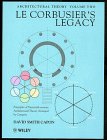Search -
Le Corbusier's Legacy: Principles of Twentieth-century Architectural Theory Arranged by Category, Volume 2, Architectural Theory
Le Corbusier's Legacy Principles of Twentiethcentury Architectural Theory Arranged by Category Volume 2 Architectural Theory
Author:
The two volumes of Architectural Theory bring together the fundamental elements of architecture and present them in a new and accessible format. The books define the areas of knowledge necessary for successful design and criticism and, for the first time in the history of architectural literature, integrate all the concepts to form a balanced an... more »
Author:
The two volumes of Architectural Theory bring together the fundamental elements of architecture and present them in a new and accessible format. The books define the areas of knowledge necessary for successful design and criticism and, for the first time in the history of architectural literature, integrate all the concepts to form a balanced an... more »
ISBN-13: 9780471985891
ISBN-10: 0471985899
Publication Date: 2/24/1999
Pages: 456
Rating: ?
ISBN-10: 0471985899
Publication Date: 2/24/1999
Pages: 456
Rating: ?
0 stars, based on 0 rating
Genres:
- Engineering & Transportation >> Architecture >> Criticism
- Engineering & Transportation >> Architecture >> General
- Engineering & Transportation >> Architecture >> Individual Architects & Firms >> Le Corbusier
- Reference >> Architecture
- Engineering & Transportation >> Architecture >> History




